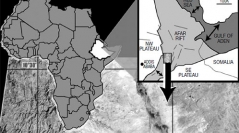

 Geodiversitas
27 (1) - Pages 133-158
Geodiversitas
27 (1) - Pages 133-158A morphometric analysis of third metapodials and first phalanges of Middle Awash and Hadar hipparions dating from the 6.0-3.0 Ma interval was conducted using two methods. Morphological comparisons using standard metrics were made using: 1) log10 ratio diagrams; 2) size independent variables developed with reference to scaling trends for hipparions in general. Results of these analyses suggest that hipparion diversity during this temporal interval was relatively low. A single dominant gracile lineage of Eurygnathohippus Van Hoepen, 1930, most plausibly derived from the Lothagam (Kenya) species Eurygnathohippus feibeli (Bernor & Harris, 2003), would appear to have persisted throughout this interval and is marked by increases in size with measured change in metapodial and phalangeal morphology. A rarer, more robust form is found in the Ethiopian sample at 4.0 Ma and is morphometrically similar to Eurygnathohippus turkanense Hooijer & Maglio, 1973 from late Miocene horizons of Lothagam. Another smaller form, of uncertain systematic status, appears likely late in the Kada Hadar sequence, c. 3.0 Ma.
Mammalia, Equidae, hipparionine, Ethiopia, Middle Awash, Hadar, postcranials, morphometrics, evolution